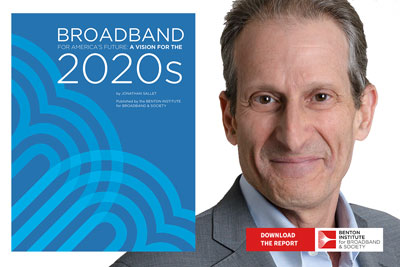Libraries and Schools Join Hands to Connect New Mexico Pueblos
Monday, October 14, 2019
Digital Beat
Libraries and Schools Join Hands to Connect New Mexico Pueblos

On October 30, the Benton Institute for Broadband & Society will be releasing Broadband for America's Future: A Vision for the 2020s. The release is a major step in a multi-year effort to update America’s approach to broadband access for the coming decade. Over the last year or so, we've been speaking with people around the country about how communities are addressing their broadband needs. We know that community anchor institutions — schools, libraries, healthcare providers and others — play a key role in bringing service to broadband deserts. Our friends at the American Library Association (ALA) alerted us to how the Middle Rio Grande and Jemez-Zia Pueblo Tribal Consortia are connecting pueblos in New Mexico. As the release of our report nears, we think it is important to share some of the innovative solutions that we've heard.
Slightly over half of Native Americans living on tribal lands (53 percent) have access to broadband internet service, according to the U.S. Census Bureau’s 2018 American Community Survey, far below the national average (78 percent) and well below even the average rate in rural counties (65 percent). Many factors limit the deployment of broadband infrastructure on tribal lands, including rugged terrain, low population density, and complicated rights-of-way agreements and easements. All of these drive up costs, increase uncertainty, and often cause delays when deploying advanced communications infrastructure.
Because Indian country has some of the highest levels of unemployment and poverty in the United States, the inability to afford broadband service also limits its adoption on tribal lands.
A forthcoming case study by the ALA examines how tribal libraries and schools in north-central New Mexico came together to address their own broadband connectivity challenges. As Kimball Sekaquaptewa, now chief technology director at Santa Fe Indian School, said, “If the incumbent providers weren’t willing to build out in our area, we were willing to own and operate our own internet infrastructure.”
Forming two separate consortia, tribal libraries and schools in six pueblos were able to aggregate their demand for broadband and build two 60-mile fiber-optic networks. Applying together through consortia applications and pursuing a regional approach yielded greater results than operating alone. Over 90 percent of the $4.2 million project was funded directly by the largest E-Rate award in the state of New Mexico in 2016 and the first tribal project of its kind since the FCC’s E-Rate modernization order in 2014.
Key takeaways from these efforts include:
Leadership, Cooperation, and Coordination. Because librarians, education directors, tribal administrators, and IT staff came together to navigate the application process, engage pueblo leadership, and coordinate with broader New Mexico state efforts, they were able to advocate and move the project forward. Tribal librarians played a pivotal role in educating their tribal leadership about the importance of broadband access and services. And they will continue to play a vital role in digital inclusion and digital literacy efforts, bridging generational divides and integrating new technologies to support their traditional communities.
Consortium Approach. The impetus for the effort was language preservation. The broadband network facilitated distance learning by connecting tribal libraries to the Santa Fe Indian School, which is owned and operated by nineteen New Mexico pueblos. The collaboration of neighboring tribes aggregated the demand for broadband and made it possible to build a higher-quality network.
State Government Support. Working with the State of New Mexico, the consortia gained insight into the E-Rate program as well as garnering assistance with filing its E-Rate application. The consortia also obtained state funding that delivered additional discounts through the E-Rate program.
Design of Self-Provisioned Networks. The consortia combined its own network with leased dark fiber and connected to a regional network to dramatically increase capacity (from 3Mbps to 100 Mbps) and decrease costs (from $106 per Mbps to $7 per Mbps). The design of the network opens countless opportunities for new services and next-generation educational networks in tribal libraries and schools.
There are nineteen pueblos in New Mexico. The Middle Rio Grande and Jemez-Zia Pueblo Tribal Consortia project, which connects six of these pueblos, continues to meet and plan connections to other pueblos and tribal networks. These tribally owned and operated networks provide the capacity needed for the foreseeable broadband needs of these communities, thus furthering the affordability and adoption of broadband in Indian country.
Later this week, the Schools, Health & Libraries Broadband (SHLB) Coalition is holding its annual conference, AnchorNets2019. Benton Board Member and former-Federal Communications Commission Chairwoman Mignon Clyburn will be moderating a panel on which I’ll give a preview of the Benton broadband report and be joined by Larra Clark from the ALA, Joe Sawasky from the Merit Network, and Luis Wong from the Imperial County Office of Education. We have much to say about the special role anchor institutions play in bridging the digital divide.
And for more on Broadband for America's Future: A Vision for the 2020s, please sign up for updates.
Jonathan Sallet is a Benton Senior Fellow. He works to promote broadband access and deployment, to advance competition, including through antitrust, and to preserve and protect internet openness. He is the former-Federal Communications Commission General Counsel (2013-2016), and Deputy Assistant Attorney General for Litigation, Antitrust Division, US Department of Justice (2016-2017).
The Benton Institute for Broadband & Society is a non-profit organization dedicated to ensuring that all people in the U.S. have access to competitive, High-Performance Broadband regardless of where they live or who they are. We believe communication policy - rooted in the values of access, equity, and diversity - has the power to deliver new opportunities and strengthen communities.
© Benton Institute for Broadband & Society 2019. Redistribution of this email publication - both internally and externally - is encouraged if it includes this copyright statement.
For subscribe/unsubscribe info, please email headlinesATbentonDOTorg







